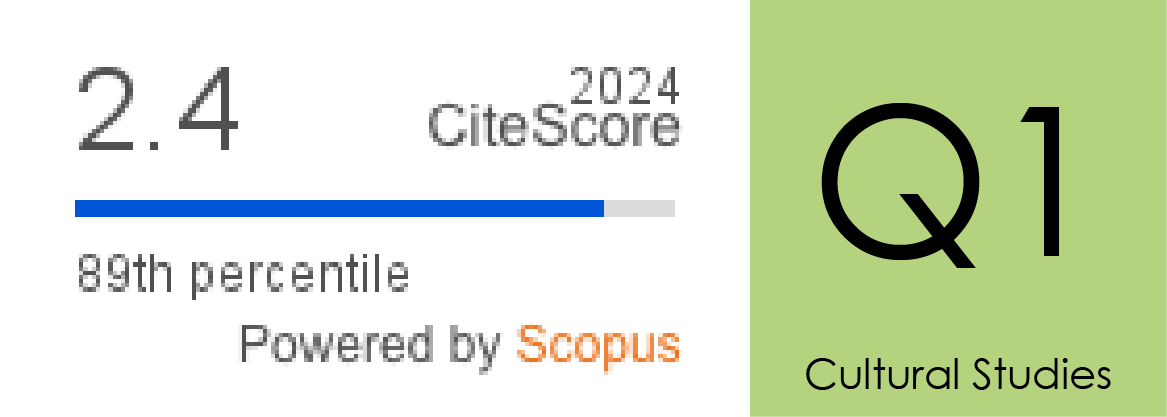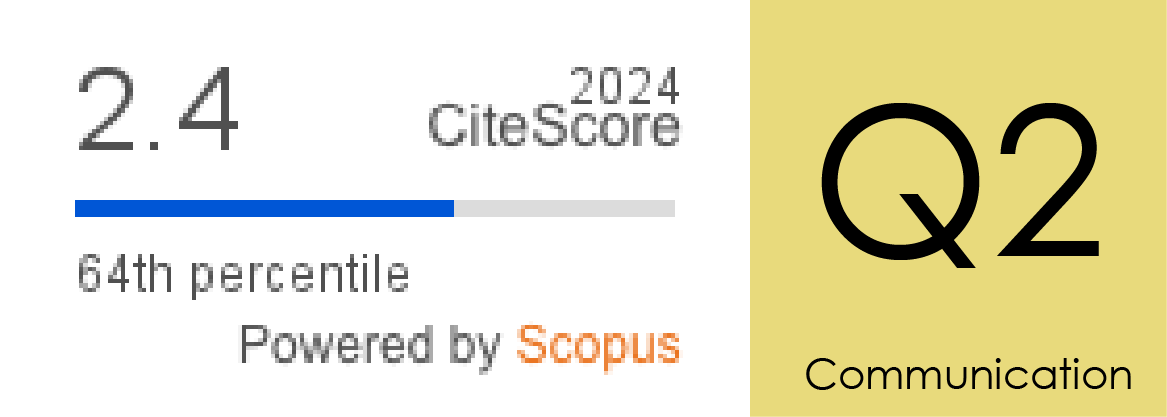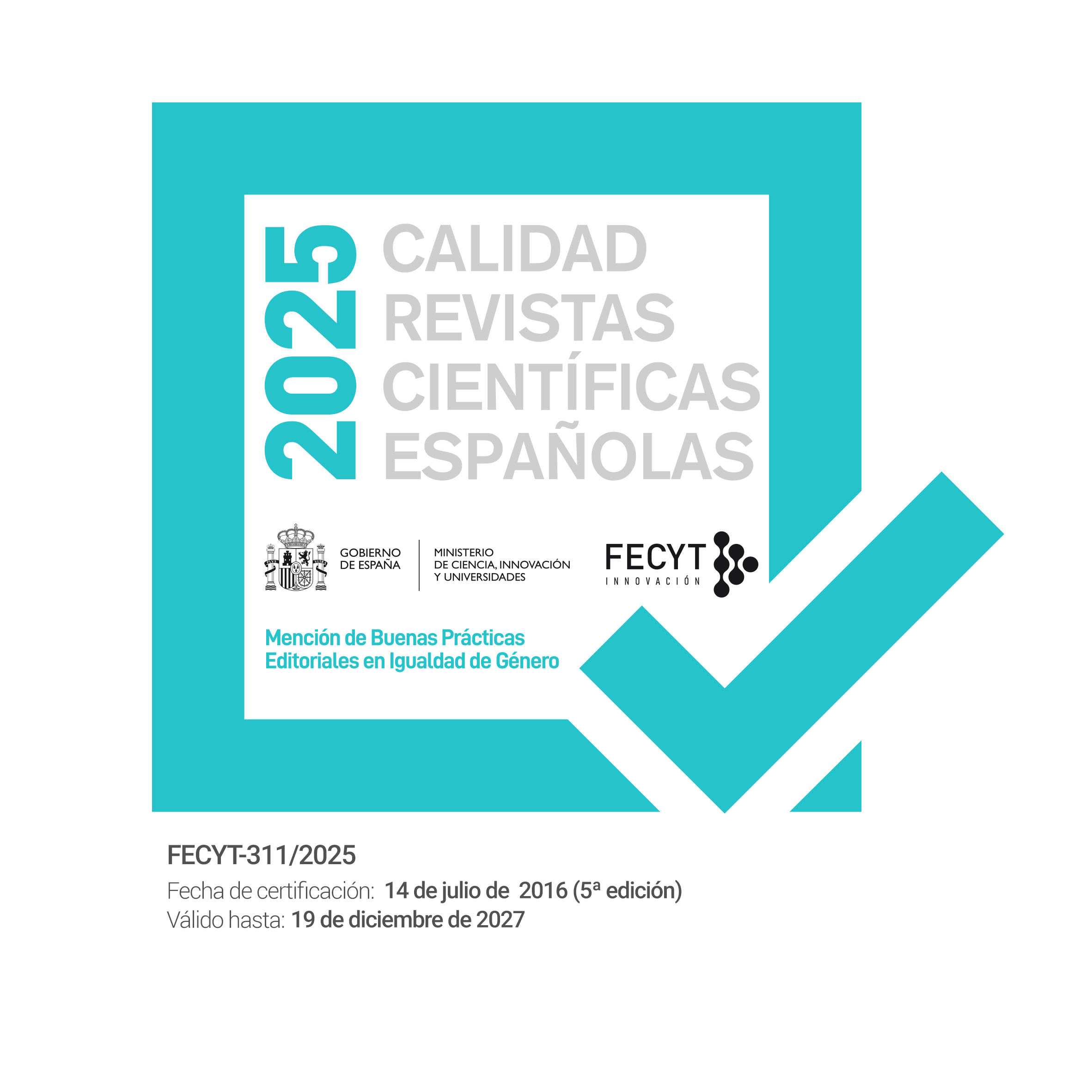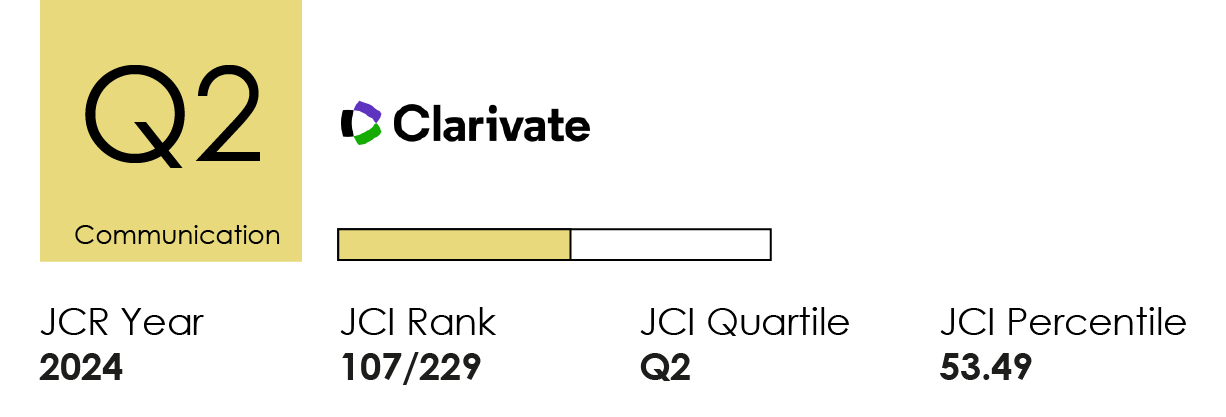Innovación con impacto: claves para una gestión eficaz de los laboratorios de medios
DOI:
https://doi.org/10.14198/MEDCOM.29710Palabras clave:
innovación, laboratorios de medios, periodismo, metodologías ágiles, equipos interdisciplinarios, transferencia de conocimientoResumen
Propósito. Este artículo identifica buenas prácticas que optimizan el funcionamiento de los laboratorios de medios como espacios clave para la innovación periodística. Metodología. Se emplea un enfoque cualitativo basado en la revisión de literatura y 21 entrevistas en profundidad a expertos académicos y profesionales vinculados a laboratorios de medios en España (2021-2025), cuyo análisis fue codificado con el software Atlas.ti. Resultados y conclusiones. Los hallazgos revelan que la operatividad de estos espacios depende de factores como el respaldo institucional, la autonomía operativa, el uso de metodologías ágiles, la existencia de equipos interdisciplinarios y una cultura de innovación distribuida en toda la organización. Además, se subraya la importancia de establecer mecanismos de transferencia del conocimiento para evitar que los laboratorios operen como unidades aisladas. Aportación original. El estudio propone un modelo sistematizado de buenas prácticas para laboratorios de medios, que refuerza su capacidad de experimentación y de transformación organizacional, al tiempo que articula estrategias para maximizar su impacto en la redacción.
Citas
Alblooshi, A. (2017). A case exploration of the critical success factors of innovation: implications for the UAE. Dissertation submitted in fulfilment of the requirements for the degree of MSc Project Management at The British University in Dubai. https://bspace.buid.ac.ae/handle/1234/1401
Atkins, R. (2022). Journalism is not a given in people’s lives. Here’s how to rethink the future of news. Reuters Institute. https://reutersinstitute.politics.ox.ac.uk/news/journalism-not-given-peoples-lives-heres-how-rethink-future-news
Braun, V., & Clarke, V. (2021). Thematic analysis: A practical guide. SAGE Publications.
Cools, H., Van Gorp, B., & Opgenhaffen, M. (2022). New Organizations, Different Journalistic Roles, and Innovative Projects: How Second-generation Newsroom Innovation Labs are Changing the News Ecosystem. Journalism Practice, 18(6), 1605–1620. https://doi.org/10.1080/17512786.2022.2097940
Cools, H., Van Gorp, B., & Opgenhaffen, M. (2023). Newsroom Engineering Teams as “Survival Entities” for Journalism? Mapping the Process of Institutionalization at The Washington Post. Digital Journalism, 12(2), 171–190. https://doi.org/10.1080/21670811.2023.2195115
Ekdale, B., Singer, J.B., Tully, M., & Harmsen, S. (2015). Making Change: Diffusion of Technological, Relational, and Cultural Innovation in the Newsroom. Journalism & Mass Communication Quarterly, 92(4), 938-958. https://doi.org/10.1177/1077699015596337
Galbraith, C.S. (1990). Transferring core manufacturing technologies in high tech firms. California Management Review, 32(4), 56-70. https://doi.org/10.2307/41166628
García-Avilés, J.A. (2018). Resultados de la innovación en los laboratorios de medios: el caso de El confidencial.LAB. Profesional de la información, 27(2), 359–366. https://doi.org/10.3145/EPI.2018.MAR.14
Glaser, B.G., & Strauss, A.L. (1967). The discovery of grounded theory: Strategies for qualitative research. Aldine Publishing.
González Alba, J.A., Caro González, F.J., Rojas Torrijos, J.L., & Pérez Curiel, C. (2023). Innovación en el periodismo desde perfiles no periodísticos. Estudio comparado de cinco media labs iberoamericanos. Doxa Comunicación, 37, 431-452. https://doi.org/10.31921/doxacom.n37a1839
Glaser, E.M., Abelson, H.H., Garrison, K.N. (1983). Putting Knowledge to Use. Jessey-Bass.
Guest, G., Bunce, A., & Johnson, L. (2006). How many interviews are enough? An experiment with data
saturation and variability. Field Methods, 18(1), 59–82. https://doi.org/10.1177/1525822X05279903
Hennink, M.M., Kaiser, B.N., & Marconi, V.C. (2017). Code saturation versus meaning saturation: How many interviews are enough? Qualitative Health Research, 27(4), 591-608. https://doi.org/10.1177/1049732316665344
Herrera-Damas, S., & Satizábal-Idarraga, C.C. (2023a). Media labs: journalistic innovation, evolution and future according to experts. Profesional de la información, 32(2). https://doi.org/10.3145/epi.2023.mar.07
Herrera-Damas, S., y Satizábal-Idarraga, C.C. (2023b). Los labs de medios en España como agentes catalizadores de la innovación periodística: rasgos centrales a juicio de los expertos. Doxa Comunicación, 37, 479-500. https://doi.org/10.31921/doxacom.n37a1836
Herrera-Damas , S., & Satizábal-Idarraga, C.C. (2024). Media labs as catalysts of journalistic innovation: Advantages and disadvantages according to experts. Journal of Applied Journalism & Media Studies. https://doi.org/10.1386/ajms_00129_1
Hogh-Janovsky, I., & Meier, K. (2021). Journalism Innovation Labs 2.0 in Media Organisations: A Motor for Transformation and Constant Learning. Journalism and Media, 2(3), 361–378. https://doi.org/10.3390/JOURNALMEDIA2030022
Koivula, M., Laaksonen, S.M., & Villi, M. (2022). Practical, Not Radical: Examining Innovative Learning Culture in a Public Service Media Organization. Journalism Studies, 23(9), 1018–1036. https://doi.org/10.1080/1461670X.2022.2065339
Lewis, M., & Moultrie, J. (2005). The Organizational Innovation Laboratory. Creativity and Innovation Management, 14, 1, 73-83. https://doi.org/10.1111/j.1467-8691.2005.00 327.x
Meier, K.; Graßl, M.; García‐Avilés, J.A.; Mondéjar, D., Kaltenbrunner, A.; Lugschitz, R.; Porlezza, C.; Mazzoni, P.; Wyss, V., & Saner, M. (2024). Innovations in Journalism as Complex Interplay: Supportive and Obstructive Factors in International Comparison. Media and Communication, 12, https://doi.org/10.17645/mac.7443
Møller, L.A. (2023). Bridging the Tech-Editorial Gap: Lessons from Two Case Studies of the Development and Integration of Algorithmic Curation in Journalism. Journalism Studies, 24(11), 1458–1475. https://doi.org/10.1080/1461670X.2023.2227283
Olsen, R.Kr., & Hess, K. (2023). “It’s New to Us”: Exploring Authentic Innovation in Local News Settings. Media and Communication, 12. https://doi.org/10.17645/mac.7444
Pérez-Seijo, S., & Silva-Rodríguez, A. (2024). Innovation in Digital Media beyond Technology: The Audience-Centered Approach and Pending Challenges. Journalism and Media, 5(1), 311-324. https://doi.org/10.3390/journalmedia5010021
Peters, C., & Carlson, M. (2018). Conceptualizing change in journalism studies: Why change at all? Journalism, 20(5), 637-641. https://doi.org/10.1177/1464884918760674
Porcu, O., Hermans, L., & Broersma, M. (2024). Creative Autonomy in the Newsroom: How Hierarchy Impacts Innovative Behaviour. Journalism Practice, 1–20. https://doi.org/10.1080/17512786.2024.2310056
Rogers, E.M. (1962). Diffusion of innovations. New York: The Free Press
Sahin, I. (2006). Detailed Review of Rogers’ Diffusion of Innovations Theory and Educational Technology: Related Studies Based on Rogers’ Theory. The Turkish Online Journal of Educational Technology, 5, 14-23
Salaverría, R. (2015). Los labs como fórmula de innovación en los medios. Profesional de la información, 24(4), 397–404. https://doi.org/10.3145/epi.2015.jul.06
Santarsiero, F.; Schiuma, G., & Carlucci, D. (2022). Driving organizational digital transformation through innovation labs. In Public Innovation and Digital Transformation. Routledge, 154–164.
https://doi.org/10.4324/9781003230854-9
Sonni, A. F., Hafied, H., Irwanto, I., & Latuheru, R. (2024). Digital Newsroom Transformation: A Systematic Review of the Impact of Artificial Intelligence on Journalistic Practices, News Narratives, and Ethical Challenges. Journalism and Media, 5(4), 1554-1570. https://doi.org/10.3390/journalmedia5040097
Szulanski, G. (1996). Exploring internal stickiness: Impediments to the transfer of best practice within the firm. Strategic Management Journal, 17(S2), 27-43. https://doi.org/10.1002/smj.4250171105
Szulanski, G. (2000). The Process of Knowledge Transfer: A Diachronic Analysis of Stickiness. Organizational Behavior and Human Decision Processes, 82(1), 9-27. https://doi.org/10.1006/obhd.2000.2884
Tanaka, A. (2011). Situating Within Society: Blueprints and Strategies for Media Labs. En Plohman, A. (ed.). Blueprint for a Lab of the Future. Baltan Laboratories, 12-20.
Tyre, M.J. (1991). Managing the introduction of new process technology: International differences in a multi-plant network. Research Policy, 20(1), 57-76. https://doi.org/10.1016/0048-7333(91)90084-4
Valero-Pastor, J.M., & Carvajal, M. (2019). Transferencia de conocimiento para la innovación en las organizaciones periodísticas. Estudio de casos españoles. Revista Latina de Comunicación Social, 74, 1154-1172. https://doi.org/10.4185/RLCS-2019-1376
Van der Meer, R.J., Selig, C.J., & Stettina, C.J. (2021). Innovation Labs: A Taxonomy of Four Different Types. IEEE International Conference on Engineering and Technology, 1–9. https://doi.org/10.1109/ICE/ITMC52061.2021.9570259
Viki, T. (2018). The Myth of The Innovation Lab. Forbes. https://www.forbes.com/sites/tendayiviki/2018/04/15/the-myth-of-the-innovation-lab/#591890544125
Wenger, E. (1998). Communities of Practice: Learning, Meaning and Identity. Cambridge University Press.
Wonglimpiyarat, J. (2022). Media Lab: Infrastructure of Innovative Capacity. International Journal of Innovation and Technology Management. https://doi.org/10.1142/s0219877023500268
Xiao, Q., Fan, X., Simon, F. M., Zhang, B., & Eslami, M. (2024). “It Might be Technically Impressive, But It’s Practically Useless to Us”: Practices, Challenges, and Opportunities for Cross-Functional Collaboration around AI within the News Industry. arXiv.Org, abs/2409.12000. https://doi.org/10.48550/arxiv.2409.12000
Zambelli, G., & Morganti, L. (2023). Breaking Away from Hectic Daily Media Production: Unleashing Explorative Innovation Through Inter-Firm Collaborations. Media and Communication, 12. https://doi.org/10.17645/mac.7414
Zambelli, G., Morganti, L., & Stas, L. (2025). An emerging avenue of media innovation: knowledge exchange in inter-firm collaborations. Journal of Media Business Studies, 1–19. https://doi.org/10.1080/16522354.2025.2454150
Zaragoza Fuster, M.T. & García Avilés, J.A. (2020). The Role of Innovation Labs in Advancing the Relevance of Public Service Media: The Cases of BBC News Labs and RTVE Lab. Communication & Society, 33, (1), 45-61. https://doi.org/10.15581/003.33.34466
Zaragoza Fuster, M.T., & García Avilés, J.A. (2022). Public Service Media laboratories as communities of practice: implementing innovation at BBC News Labs and RTVE Lab. Journalism Practice, 18(5), 1256–1274. https://doi.org/10.1080/17512786.2022.2088602
Descargas
Publicado
Cómo citar
Número
Sección
Licencia
Derechos de autor 2018 Susana Herrera-Damas, Christian-Camilo Satizábal-Idarraga

Esta obra está bajo una licencia internacional Creative Commons Atribución 4.0.
Los autores y autoras que publican en esta revista están de acuerdo con los siguientes términos:
1 Derechos de autor. Los autores y autoras conservan sus derechos de autor, aunque ceden a la revista de forma no exclusiva los derechos de explotación (reproducción, distribución, comunicación pública y transformación) y garantizan a esta el derecho de primera publicación de su trabajo, el cual estará simultáneamente sujeto a la licencia indicada en punto 2. Los autores pueden establecer otros acuerdos adicionales para la distribución no exclusiva de la versión de la obra publicada en la revista, siempre que exista un reconocimiento de su publicación inicial en esta revista.
© Los autores.
2 Licencia. Los trabajos se publican en la revista sujetos a la licencia de Reconocimiento 4.0 Internacional de Creative Commons (CC BY 4.0); los términos se pueden consultar en https://creativecommons.org/licenses/by/4.0/
Esta licencia permite a terceros compartir (copiar y redistribuir el material en cualquier medio o formato) y adaptar (remezclar, transformar y crear a partir del material para cualquier finalidad, incluso comercial), siempre que se reconozca la autoría y la primera publicación en esta revista (Revista Mediterránea de Comunicación (RMC) / Mediterranean Journal of Communication (MJC), Universidad de Alicante, DOI de la obra), se proporcione un enlace a la licencia y se indique si se han realizado cambios en la obra.
3 Política de autoarchivo. Se recomienda a los autores que difundan sus trabajos a través de Internet para favorecer una circulación y difusión más rápidas y, con ello, un posible aumento en la citación y alcance entre la comunidad científica y académica, en las siguientes condiciones:
No se permite a los autores depositar en un repositorio institucional o temático, página web propia, etc., las versiones preprint (versión antes de ser evaluada) o postprint (versión evaluada y aceptada para su publicación) de sus trabajos antes de su publicación, pero sí el artículo final publicado (versión del editor).













